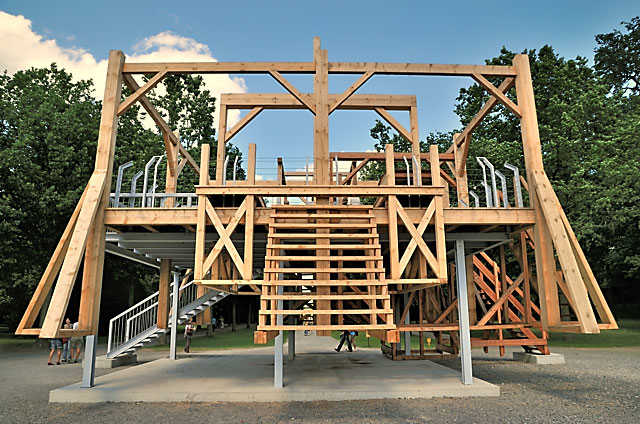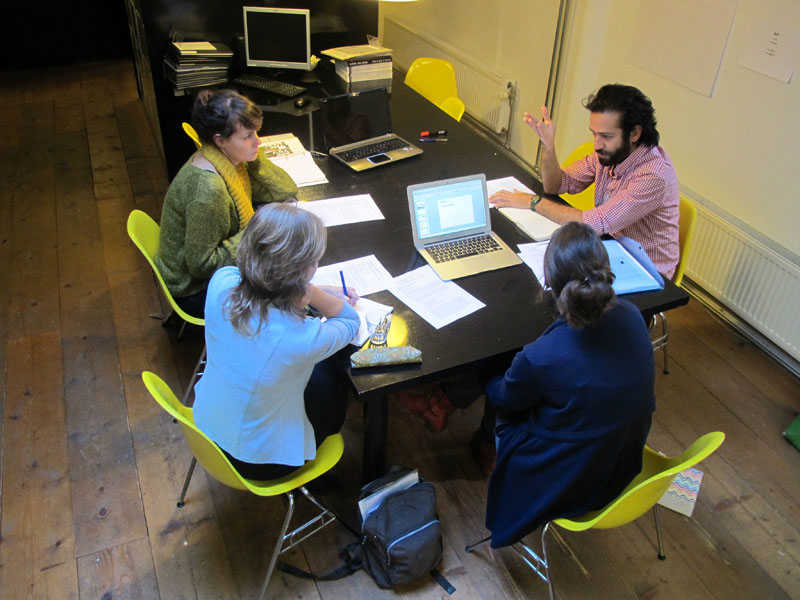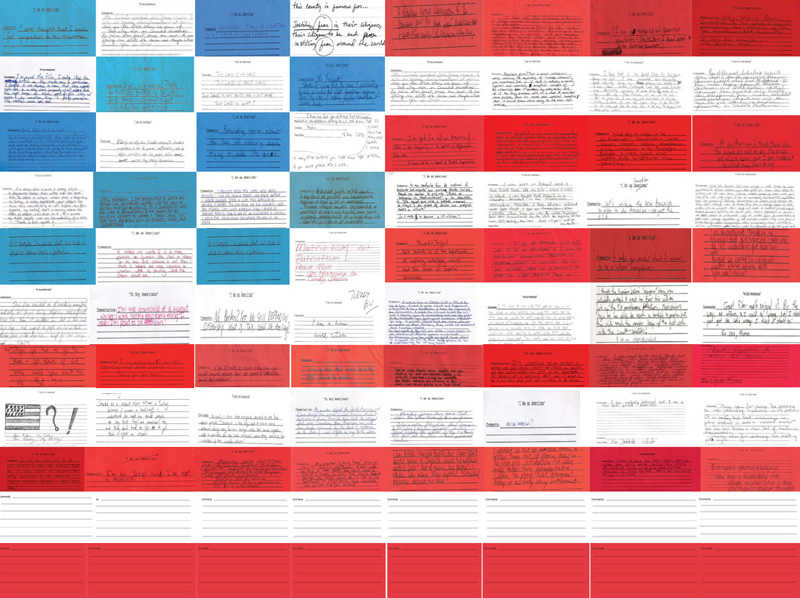Outside Academy joins SEE YOU IN THE HAGUE/ participants: students and alumni / Masterclass: Consequences of Counterterrorism Policies
Participants: Silvia Uloa, Louis Liu, Kim Schonewille, Coco Duivenvoorde, Monique Hendriksen, Pendar Nabipur, Suzanne van Rest, Anna Hoetjes, Doris Dennekamp, Taf Hassam, Katja van Driel
This project takes places outside DAI-weeks and is open to both students and alumni. Florian Göttke will act as the intermediary between DAI and See You In The Hague. ECTS - study points will be accredited to the participating DAI-students. See You In The Hague's curator in chief is Brigitte van der Sande
15 Nov, 10-15:00 – masterclass
6 Dec, 10-15:00 – masterclass
10 Jan, 13-17:00 – public presentation
See You in The Hague / Masterclass-Design Studio: Preemption, Politics, Alternatives
Coordinated by Marieke de Goede & Floris Vermeulen
University of Amsterdam, department of political science
m.degoede@uva.nl & f.f.vermeulen@uva.nl
For more information, please contact
Brigitte van der Sande: sandebb@xs4all. nl
Introduction
Contemporary counterterrorism as well as security politics more generally increasingly display a desire for preemption, whereby potential future threats are identified, prepared for and preempted at the earliest possible stage. Through imaginative scenario methods that prepare for the worst, preemptive actions into a diversity of mundane policy areas are enabled and enacted. From countering radicalisation, to identifying and detaining suspicious travelers before they reach the border, from preemptive raiding to the pursuit of terrorist monies, contemporary security focuses on addressing threats before they fully materialize. The state has an important function in protecting citizens from violence and terrorist attacks. The costs and consequences of preemptive counterterrorism, however, are little understood and debated. Side-effects of preemptive interventions have been well-documented, including, for example, the breach of human rights in blacklisting cases, the impact on freedom on (Islamic) charitable giving, or the construction of suspect communities. It is important to understand that traditional modes of government accountability are difficult to sustain in the face of a threat thought to be at once unknowable and potentially catastrophic. Against the supposed potential catastrophic nature of the threat, conventional policy evaluation in terms of cost- effectiveness and policy success have largely lost their capacity to hold specific measures to account. But is it possible to develop alternative scenarios in which the security aspect and the possible side-effects of state interventions are more in balance? If so, what could such alternatives look like? What are the political alternatives to acting preemptively in the contemporary security conjunction? What political modes and means of questioning can be developed to hold preemptive power to account? What is the role of art and literature in (1) articulating grievances and protest against state interventions, (2) imagining alternatives and acting as a 'tool for rupture' challenging narratives the state's symbolic power, and (3) imagining alternative scenarios for communicating state interventions to target groups and society in general?
This Masterclass sets out these political questions that arise from preemptive security politics, and actively engages a diverse student audience in the formulation of political questions and the imagination of novel ways to hold executive power to account, study effects of interventions and come to alternative scenarios for future security interventions in which art plays an important role.
The Masterclass brings together students from different backgrounds (arts, academia/political science and military) in three sessions in which students study, discuss and engage with these political questions and collectively design alternatives.
Session 1: Preemption & Counterterrorism
November 15
Location: Stroom Den Haag, Hogewal 1-9, The Hague, 070-3658985
10.00-13.00: Masterclass Meeting first half:
• Lecture by Marieke de Goede on the politics of preemption, the relationship between prevention, preemption, precaution and the question of politics.
• Lecture by Jenifer Chao on the space of art and culture as oppositional practice.
Meeting second half:
• Students meeting and dialogue
• Small group work. Study the necessity and problems of politics of preemption. Assignment on mapping and discussing the use of art and culture as oppositional in security issues.
Required reading:
• Aradau, C., & Van Munster, R. (2011). Politics of catastrophe: Genealogies of the unknown. Routledge. Introduction & chapter 1.
•De Goede, Marieke (2012) Speculative Security: the Politics of Pursuing Terrorist Monies. Minneapolis: University of Minnesota Press. Conclusion.
• Mitchell, W. J. T. (2008). Cloning terror: The war of images 2001–2004. The life and death of images: Ethics and aesthetics, 179-207.
• McKee, Y. (2006) 'Suspicious Packages*' 117, 99-121 MIT Press 13:00 Lunch provided by STROOM 14.00-15.00 (Optional)
Guided tour by the Dutch artist Charles van Otterdijk through his exhibition 'Double Center' at Stroom
Stroom Den Haag and the Van Abbemuseum (and Book Works, London) are teaming up to present the art project Double Centre. The title of this several-year endeavour refers to two mysterious sites in the former DDR, and the Kafka-like situations Charles van Otterdijk experienced when attempting to interpret these spaces. In this search, Double Centre takes the visitors into a twilight zone where the borderlines between legal and illegal, and fiction and reality, become blurred. The results of his ongoing investigation will be shown in two exhibitions – as separate, interim reports – and an accompanying publication. Charles van Otterdijk discovered the locations by chance in the vast woodlands near the Oder-Niesse line. What the precise function of these buildings was, is completely unclear. Considering their locations, illegality – institutional or otherwise – cannot be ruled out. What's more, Van Otterdijk seems to have been observed, and he felt compelled to take to his heels. Working from memory and sparse documentation, he is attempting a reconstruction under the title Double Centre. With the help of photographs, security camera footage and several reconstructed objects, he tries to come to grips with the possible meaning of these sites. Why are they so hidden? Are they a post-9/11 sanctuary, or were they in fact used as surveillance centers? Double Centre evokes associations with rendition centres and other practices employed by democratic constitutional states in their attempt to eliminate terrorists, suspected or otherwise. This method often takes place in a no man's land, out of sight of the media and legal and parliamentary control. Double Centre transports the visitor into a similar twilight zone. One can't help wondering, what would we actually consider permissible in order to defend our constitutional state?
Session 2: Scenarios & Alternatives
December 6
Location: Stroom Den Haag, Hogewal 1-9, The Hague, 070-3658985
10.00-13.00 Masterclass Meeting first half:
• Lecture by Floris Vermeulen on different state interventions in Europe against terrorism, possible (side-)effects, and suspect communities.
• Lecture by Stephanie Simon on resilience in urban design
Meeting second half:
• Small group work. Study the side-effects of a politics of preemption. Study communication strategies of states to inform and include the public and target group about security interventions.
• Assignment on scenarios and developing and communicating alternatives when dealing with uncertain but potentially catastrophic futures. Students will be asked to find and show examples of the way in which art, culture, literature help create thinking-space and challenge existing boundaries of political debate.
Readings:
• Vermeulen, F. (2014) 'Suspect Communities. Targeting Violent Extremism on the Local Level: Policies of Engagement in Amsterdam, Berlin, and London', Terrorism & Political Violence forthcoming.
• Lum, C., Kennedy, L. W., & Sherley, A. (2006). Are counter-terrorism strategies effective? The results of the Campbell systematic review on counter-terrorism evaluation research. Journal of Experimental Criminology, 2(4), 489-516. http://gunston.gmu.edu/cebcp/Publications/Terrorism%20Review%20JEC.pdf
• Coaffee, J. (2013). Rescaling and Responsibilising the Politics of Urban Resilience: From National Security to Local Place-‐Making. Politics, forthcoming.
• Fuerer, Alan (2012) 'Protecting the City, Before Next Time,' New York Times, November 3, available at: http://www.nytimes.com/2012/11/04/nyregion/protecting-new-york-city- before-next-time. html?pagewanted=all&_r=2&
13:00 Lunch provided by STROOM
14.15-15.15 (Optional) Guided tour by Stroom advisor art in public space Vincent de Boer to 'Scaffold', a work of the American artist Sam Durant, located on the President Kennedylaan opposite Museon (by bike or bus 24 stop Gemeentemuseum/Museon)
Scaffold is a monumental construction of piled-up wooden scaffolds that Sam Durant installed in 2012 during the international exhibition dOCUMENTA 13 in the German city of Kassel, on the intersection of two lanes in Karlsaue Park. At first sight seeming more like a children's jungle gym or a lookout post than a criticism of the death penalty in the United States, the meaning of the sculpture becomes apparent when one climbs the steps. The scaffolds represent the sites of what by now have become almost iconic public executions, beginning with the stringing up of slavery abolitionist John Brown in 1859 and ending with the execution of Saddam Hussein in 2006. Paradoxically enough, then-President George W. Bush greeted the news of Hussein's execution as an important milestone in Iraq's development as a democracy. As a response to the essay 'Is the Death Penalty Dying: European and American Perspectives' (2011) by P.C. Spierenburg, Professor of Criminology at Erasmus University, Durant approached Stroom with a request to set up Scaffold in the heart of the international city of peace and justice. Within the framework of See You in The Hague, the monument will literally be activated as a platform for public debate on the death penalty, democracy, national administration of justice and international criminal law. In addition, a programme of music, dance and performance is being organized in collaboration with various partners.
Session 3: Guest Lecture Weber & Presentation of Results
Jan 10
13.00-17.00 hrs
Location: Stroom Den Haag, Hogewal 1-9, The Hague, 070-3658985
13.00 Group presentations of results and comments by teachers and guest lecturers
15:00 Keynote Lecture by Cynthia Weber (Professor of International Relations University of Sussex) & presentation of 'I am an American: Video Portraits of Unsafe US citizens'.
In 2005 Professor Cynthia Weber set out on a journey across post-9/11 America in search of a deeper understanding of what it means to be a US American today and, since the International War on Terror, what it means for US citizens to say 'I am an American'. She spent 6 years on and off filming first- person interviews in the US, Mexico, and Canada and has produced a collection of 14 short documentary films, 18 photographic portraits and an accompanying book that give voice to ordinary citizens for whom the terrorist attacks of 2001 – and their lingering aftermath – live on in collective memory.
17.00 Food & drinks



